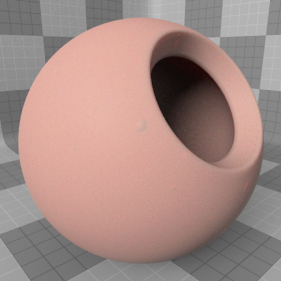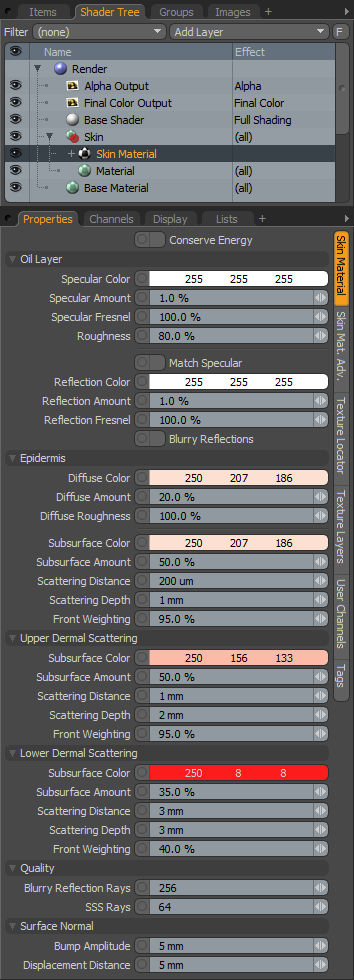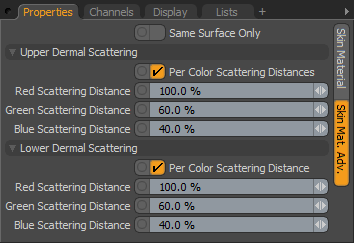
The Skin Material is designed to completely replace the default BRDF shading calculations of the standard Material item when applied to a surface. Human skin is a rather complex organ, made up of multiple layers and materials, each absorbing, scattering, and reflecting light differently creating a very subtle but distinct look that we as humans are intimately familiar with. In order to simulate such a complex surface a special Material shader was required. The material is a made up of mostly familiar options, that combine to simulate the subtle nuance that is skin.

The Skin Material item is added to the Shader Tree using the Add Layer > Custom Materials > Skin Material function.
NOTE: For more information on adding and manipulating Shader Tree layers, please see Shader Tree.
For the best results, the Skin Material should be placed above the Material Item it is replacing (feel free to disable or remove the Material Item). Once positioned, selecting the Skin Material item reveals its attributes in the Properties viewport where its settings may be adjusted to fine tune the look of the rendered skin. Skin is not a consistent color across its entire surface, so you may want to add texture layers, set to the appropriate effect to represent the natural variations inherent in skin, to produce the most realistic results. There are a number of special layer effect types specific to the Skin Material under Custom Material Channels > Skin Material Channels that correspond to the settings of the Skin Material itself.
NOTE: Since the Skin Material completely replaces the Material Item's settings, in order to obtain the best results for Bump Maps and Displacement Maps, you may need to adjust the respective attributes directly in the Skin Shader properties panel.

|
Option |
Description |
|---|---|
|
Conserve Energy |
When enabled, the material maintains a physically accurate blend of Diffuse and Specular light reflecting over the skins surface. It also accurately spreads the energy of each contribution to the oil and dermal layers so that the overall contribution is never more than 100%. |
|
Oil Layer - The uppermost layer of skin excretes an oil that produces a shiny, specular reflection on its surface. Depending on the amount on the skin, it becomes less or more reflective. Skin that is flushed, say from exercise or exertion, is shinier than clean skin or skin with powder make-up on, so the Amount and Roughness should be adjusted depending on the desired look. |
|
|
Specular Color |
Determines the color of the highlight created from reflections of direct light sources. |
|
Specular Amount |
Determines the strength of the specular highlight. |
|
Specular Fresnel |
At glancing angles (those perpendicular to the camera), reflectance values of skin increase. The Specular Fresnel setting realistically increases the specular amount at these glancing angles producing a physically correct surface. |
|
Roughness |
This control determines the size of the spread for both Specular and Blurry Reflections. A higher Roughness value produces these rougher, more spread out highlights, while lower values produce tighter more focused highlights. For example, a clay pot reflects light very differently than a porcelain cup. Though both surfaces appear to be smooth, on a microscopic level the clay pot is much rougher than the porcelain and this affects how the light is reflected, spreading the reflection across the surface. |
|
Match Specular |
When enabled, the Reflection options are automatically adjusted to match the equivalent specular settings. |
|
Reflection Color |
Determines the tinting or colorization of Reflection on the surface. |
|
Reflection Amount |
Determines the amount of the environment reflections that appear on the surface, like with the specular setting, oilier surfaces appear more reflective. |
|
Reflection Fresnel |
At glancing angles (those perpendicular to the camera), reflectance values of skin increase. The Reflection Fresnel setting realistically increases the reflection amount at these glancing angles producing a physically correct surface. |
|
Blurry Reflections |
When enabled, reflections take in to account the Roughness option and spread reflections across the surface, such as would happen with real skin. |
|
Epidermis - The epidermis is the outer layer of effectively dead skin cells. This layer is quite thin and on a microscopic level, looks very much like tiny overlapping scales. This layer is mainly responsible for the color of the skin, depending on the actual amounts of melanin present in the cells. |
|
|
Diffuse Color |
Determines the Diffuse Color of the skins surface. This is the apparent visual color of the skin's outer surface that reflects back when illuminated. |
|
Diffuse Amount |
Determines the amount of light reflected back from the skins surface, the rest of the light is absorbed for subsurface scattering (SSS). |
|
Diffuse Roughness |
The Diffuse Roughness control represents a lack of specular on a Epidermal surface, reading the Diffuse shading outwards across the surface, simulating the tiny microscopic variations of the individual skin cells. |
|
Subsurface Color |
Determines the color of the light that is absorbed, scattered and the reflected back out. The epidermis is fairly translucent and the subsurface color is basically the same color as the Diffuse Color for human skin. |
|
Subsurface Amount |
Determines the amount of scattered light that is reflected back out. The subsurface scattering is combined with the Diffuse Color to produce the final epidermal layer. |
|
Scattering Distance |
Determines the distance that light scatters through the surface before reflecting back out. Deeper rays attenuate toward the SSS color, reaching the full SSS color at the Scattering Distance value. |
|
Maximum Depth |
Determines the maximum depth to which a ray can contribute to the final solution, in essence clipping the SSS to approximate a solid core. A value of 0 disables this option. |
|
Front Waiting |
The Front Weighting option biases the SSS ray forward or backward. Settings between 0 - 49 bias the SSS rays backwards, 51 - 100 bias the rays forward, and a setting of 50 distributes the rays equally in both directions. |
|
Upper Dermal Scattering - The upper dermal layer contains tissue for cushioning the epidermis, and also houses the nerve endings, hair follicles, sweat glands, and blood vessels. Because of these constructs, the light scattered from here is differently colored than the epidermal layer. |
|
|
Subsurface Amount |
Determines the amount of scattered light that is reflected back out. Upper Dermal Scattering is combined with the Epidermal layer solution to produce the final shaded result. |
|
Scattering Distance |
Determines the distance that light scatters through the surface before reflecting back out. Deeper rays attenuate toward the SSS color, reaching the full SSS color at the Scattering Distance value. |
|
Maximum Depth |
Determines the maximum depth to which a ray can contribute to the final solution, in essence clipping the SSS to approximate a solid core. A value of 0 disables this option. |
|
Front Weighting |
The Front Weighting option biases the SSS ray forward or backward. Settings between 0 - 49 bias the SSS rays backwards, 51 - 100 bias the rays forward, and a setting of 50 distributes the rays equally in both directions. |
|
Lower Dermal Scattering - The lower dermal area contains more blood vessels and typically is the layer that contributes the most red because of this. |
|
|
Subsurface Amount |
Determines the amount of scattered light that is reflected back out. Lower Dermal Scattering is combined with the Upper Dermal and Epidermal layer solutions to produce the final shaded result. |
|
Scattering Distance |
Determines the distance that light scatters through the surface before reflecting back out. Deeper rays attenuate toward the SSS color, reaching the full SSS color at the Scattering Distance value. |
|
Maximum Depth |
Determines the maximum depth to which a ray can contribute to the final solution, in essence clipping the SSS to approximate a solid core. A value of 0 disables this option. |
|
Front Weighting |
The Front Weighting option biases the SSS ray forward or backward. Settings between 0 - 49 bias the SSS rays backwards, 51 - 100 bias the rays forward, and a setting of 50 distributes the rays equally in both directions. |
|
Quality |
|
|
Blurry Reflection Rays |
Defines the number of rays used to calculate Blurry Reflections when that option is enabled. Higher ray counts produce smoother, more realistic results, but also result in longer calculation times when rendering |
|
SSS Rays |
Defines the number of rays used to calculate the SSS results. Higher ray counts produce more accurate SSS results, but also take longer to calculate. |
|
Surface Normal |
|
|
Bump Amplitude |
Determines the maximum strength of any bump map applied to the skin surface. |
|
Displacement Distance |
Determines the maximum displacement distance when any type of displacement texture layer is used. |
Since the Skin Material uses a custom shading model to render the surface, it is not compatible with blending or masking techniques allowed by other layers. Basically this means that any surface with the skin shader applied can only be a skin surface.

|
Option |
Description |
|---|---|
|
Upper Dermal Scattering |
|
|
In real skin, each wavelength of light penetrates the skin to a different depth, which attenuates the colors slightly as rays travel further into the surface. For the most accurate results you can enable and adjust these settings, but they also increase render times as individual rays need to be fired for each wavelength calculation. |
|
|
Per Color Scattering Distances |
When enabled, this option calculates per color scattering for SSS of the Upper Dermal layer. |
|
Red/Green/Blue |
These controls allow you to adjust how each wavelength attenuates through the surface. Red, being the highest wavelength, should penetrate further than the lower wavelengths of green and then blue. Values of 100 travel the maximum Scattering Distance specified. |
|
Lower Dermal Scattering |
|
|
Per Color Scattering Distances |
When enabled, this option calculates per color scattering for SSS of the Lower Dermal layer. |
|
Red/Green/Blue |
These controls allow you to adjust how each wavelength attenuates through the surface. Red, being the highest wavelength, should penetrate further than the lower wavelengths of green and then blue. Values of 100 travel the maximum Scattering Distance specified. |